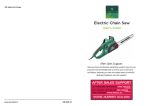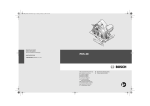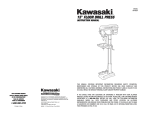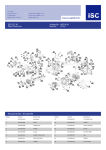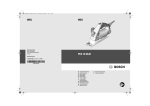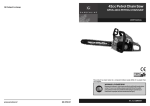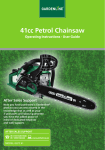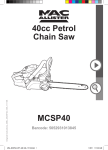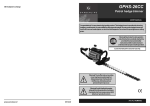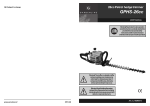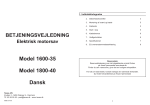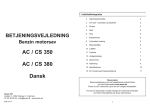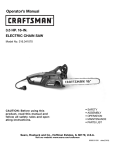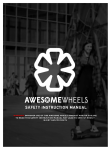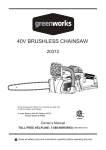Download LTM6002 ma # 0601-10
Transcript
GCS-2000 GB Subject to change 2000W Electric Chain Saw USER’S MANUAL WARNING • PLEASE READ For your own safety please read this manual before attempting to operate your new unit. Failure to follow instructions can result in serious personal injury. Spend a few moments to familiarize yourself with your trimmer before each use. www.servotool.nl GB-0604-18 Art. no. KZM6003 • 09/06 Exploded view 16 9 11 10 13 7 3 2 5 1 15 8 14 Spare parts list GCS-2000 18 02 17 4 6 19 Gardenline nr. 501532 501533 KZA1004 KZA1005 501534 501535 501536 501537 501538 501539 501540 501541 501542 501543 12 Gardenline Gardenline Description Sprocket wheel Chain adjustment (set) Chain Guide Bar 40 cm Saw Chain 40 cm Insert plate Gripping teeth Oiler cap (set) Gear complete Switch junction rod Switch + button Micro-switch Guard Carbon brush (set) Chain bar cover Position nr. 1 till 4 10, 11, 12, 14, 17 19 18 22 27 31 32 + 34 42 43 + 45 63 76 79 87 27 GB GB 2000W ELECTRIC CHAIN SAW For your own safety and for the safety of others, please read these instructions carefully before using this appliance. It will help you understand your product more easily and avoid unnecessary risks. Keep this instruction manual in a safe place for future use. Introduction This unit is designed for occasional homeowner use and should not be used for commercial purposes or subjected to heavy continuous use. Your new chain saw can by used for a variety of projects such as cutting firewood, making fence posts, felling small trees, limbing, pruning at ground level, and light carpentry. Cut only wood or wood products with your saw. Contents 1. Machine data 2. Safety rules 3. Assembly instructions 4. Operating instructions 5. Maintenance 1. MACHINE DATA Specifications Input Power No load speed Cutting speed Cutting length Net weight Oil capacity Braking time Vibration front handle Vibration rear handle Lpa (sound pressure) Lwa (sound power) 230 V~, 50 Hz 2000 W 6800/min 13.5 m/s (800 m/min) 400 mm 5.9 kg 250 ml < 0.15 sec 5.77 m/s2 4.89 m/s2 91 dB (A) 105 dB (A) General Information Page 2 1. Rear handle 2. Oil tank cap 3. Trigger start 4. Sprocket cover 5. Chain cover control knob 6. Chain tension ring 26 Gardenline Gardenline 03 GB GB 7. 8. 9. 10. 11. 12. 13. 14. 15. 16. 17. 18. 19. Electric motor Electric cord Chain brake lever/hand guard Lock / button Front handle Guide bar Saw chain Spiked bumper Rear hand guard Guide bar nose Oil tank inspection window Cord retainer Chain catcher Safety features Numbers preceding the descriptions correspond with the numbers above to help you locate the safety feature. 3 Trigger start / stop switch Stops saw motor when released. 9 Chain brake lever / hand guard Activates the chain brake and protects the operator’s left hand in the event it slips off the front handle while saw is running. 7 Electric motor Is double insulated for added safety. 10 Lock / off button Prevents accidental acceleration of the saw motor. The trigger cannot be squeezed unless lock/off button is pushed forward to end. 13 Low-kickback chain helps significantly reduce kickback, or the intensity of kickback, due to specially designed depth gauges and Guard links. 19 Chain catcher Reduces the danger of injury in the event saw chain breaks or derails during operation. The catcher is designed to intercept a whipping chain. 2. SAFETY RULES Meaning of symbols marked on the product The following pictograms are used in these instructions for use: Read the user manual before using the machine In accordance with essential applicable safety standards of European directives 04 Gardenline Gardenline 25 GB GB CE DECLARATION OF CONFORMITY (GB) Class II machine – Double insulation – You don’t need any earthed plug. Whenever the machine is in use, safety goggles must be worn to safeguard against flaying object, as must ear protectors, such as a soundproof helmet, in order to protect the operator’s hearing. If the operator is working in an area where there is a risk of falling objects, a safety helmet must also be worn. We declare under our sole responsibility that this product is in conformity with the following standards or standardized documents: EN 50144-1, EN 50144-2-13, EN55014-1, EN55014-2, EN 61000-3-2, EN 61000-3-3 Wear gloves to protect your hands in accordance with the regulations: 98/37 EEC, 73/23 EEC, 89/336 EEC Warning! Danger from 01-09-2005 ZWOLLE NL Do not expose to rain Remove plug from the mains immediately if cable is damaged or cut W. Kamphof Quality department Wear safety boots to protect against electric shock It is our policy to continuously improve our products and we therefore reserve the right to change the product specification without prior notice. Sound power level 105 dB (A) Ferm BV. Lingenstraat 6. 8028 PM Zwolle. The Netherlands Faulty and/or discarded electrical or electronic apparatus have to be collected at the appropriate recycling locations. Warning! When using electric tools, basic safety precautions, including the following, should always be followed to reduce the risk of fire, electric shock and personal injury. Read all these instructions before operating this product and save these instructions. Warning! Take care not to expose this tool to rain and remove plug from mains immediately if the supply cable is damaged. 1. 2. 24 Gardenline Keep work area clean Cluttered areas invite injuries. Do not start cutting until you have a clear work area, secure footing, and a planned retreat path from the falling tree. Consider work area environment Use extreme caution when cutting small sized brush and sapling, as slender material may catch the saw chain and be whipped toward you or pull you off balance. Do not operate a chain saw in a tree unless you are specifically trained to do so. When cutting a limb that is under tension, be alert for spring back so that you will not be struck when the tension in the wood fibers is released. Do not expose the chain saw to rain. Do not use the chain saw in damp or wet locations. Do not use the chain saw in the presence of flammable liquids or gases. Gardenline 05 GB GB 3. 4. 5. 6. 7. 8. 9. 10. 11. 12. 13. 14. 15. 16. 17. 06 Store idle chain saw When not in use, tools should be stored in a dry, high or locked up place, out of reach of children. Do not force the chain saw The chain saw will do a better and safer job when used at the rate for which it was intended. Use the right tool Cut wood only. Do not use the chain saw for purposes for which it was not intended. For example, do not use the chain saw for cutting plastic, masonry, or non-building materials. Dress properly Do not wear loose clothing or jewelry, as they can get caught in moving parts. Non-skid footwear is recommended when working outdoors. Wear protective hair covering to contain long hair. Use safety gear Use safety glasses, safety footwear, snug fitting clothing, protective gloves, and protective hearing and head gear. Carrying the saw Carry the saw by the front handle with the saw stopped. Keep your finger off the switch, and make sure that the guide bar and saw chain are to the rear. Do not abuse the cord Never carry the tool by the cord or yank it to disconnect it from the socket. Keep the cord away from heat, oil and sharp edges. Secure work Use clamps or a vice to hold the work. Do not overreach Keep proper footing and balance at all times. Maintain the chain saw with care Inspect the chain saw cords periodically and, if damaged, have them repaired by an authorized service facility. Keep the cord clear of the chain and operator at all times. Never carry the saw by the cord or pull it to disconnect from receptacle. Keep the cord from oil and sharp edges. Inspect the extension cords periodically and replace if damaged. Keep tools sharp and clean for better and safer performance. Follow instructions for lubricating and changing accessories. Keep handles dry, clean and free from oil and grease. Disconnect the chain saw Disconnect the chain saw when not in use, before servicing, and when changing accessories and attachments such as saw chain and guard. Remove adjusting keys and wrenches Form the habit of checking to see that keys and adjusting wrenches are removed from the tool before turning it on. Avoid unintentional starting Do not carry a plugged-in tool with a finger on the switch. Ensure switch is off when plugging in. Use outdoor extension leads Use only extension cords that are intended for outdoor use and which are so marked (≥ 1,5 mm2). Stay alert. Watch what you are doing. Use common sense. Do not operate the chain saw when you are tired. Keep all parts of your body away from the saw chain when the motor is operating. Before you start the saw, make sure the saw chain is not contacting anything. Gardenline Chain lubrication Always make sure the automatic oiler system is working properly. Keep the oil tank filled with special chainsaw oil. Adequate lubrication of the bar and chain during cutting operations is essential to minimize friction with the guide bar. Never starve the bar and chain of lubricating oil. Running the saw dry or with too little oil will decrease rapid cutting efficiency, shorten saw chain life, cause rapid dulling of the chain, and lead to excessive wear of the bar from overheating. Too little oil is evidenced by smoke or bar discoloration. Preventative maintenance servicing a double insulated appliance In this double insulated appliance, 2 systems of insulation, instead of grounding, are provided. No grounding means is provided on a double insulated appliance, nor should a means for grounding be added to the appliance. No serviceable parts are inside. A double insulated appliance is marked with the words, “Double Insulation” or “Double Insulated”. The symbol may also be marked on the appliance. 1. 2. 3. 4. 5. 6. 7. 8. Place switch in “off” position and unplug the power supply before the appliance is serviced, cleaned, or maintenance is performed. Keep the air intake clean and air vents free of debris to avoid overheating the motor. Clean with a damp sponge and mild soap. Do not squirt with a water hose or douse with water or other liquids. Inspect the saw chain for proper tension before each use and frequently during cutting. Sharpen as required. Clean the guide bar and bar pad to ensure free path for oil. Turn the bar over after each use to achieve even wear. No motor lubrication is necessary. The motor is equipped with lifetime lubricated bearings. If the saw does not operate, turn switch to OFF position and disconnect the extension cord, first from the power supply, then from the saw. Check the power supply for blown fuses or tripped circuit breakers. If it still does not operate, contact your local dealer. Do not attempt to repair it yourself. No serviceable parts are inside. Gardenline 23 GB GB Warning! The risk of kick-back increases when: • file-angle is too big • cutting-angle is too small • diameter of round file is too small B. Sharpening the tooth To sharpen the teeth of the saw you need a round file and a file mould. Consult a specialist store in chain saws for these items. 1. 2. 3. 1 5 Fig. 17 Check if the chain is stretched out completely. Otherwise the chain is not stable enough and cannot be sharpened correctly. Always file from the inside of the tooth to the outside. Always lift up the file when you start sharpening another tooth. First file all teeth on one side, turn round the chain saw and then file the teeth on the other side. After filing, the teeth should all have the same length. When the length of the teeth is only 4 mm, the chain is worn and should be replaced. C. The cutting-depth When you sharpen the teeth, the cutting-depth will decrease. To maintain the maximum saw capacity, the ridge (B) has to be lowered. To attain a perfect cutting-depth you should use also a depthmould. Consult a specialist store in chain saws for the specific tool and measurements. Adjusting the cutting-depth has to be done directly after the teeth are sharpened. You use a flat file and a depthmould for this. The cutting-depth is correct when you don’t feel resistance anymore, while moving the file across the mould. Chain tension Check the chain tension frequently and adjust as often as necessary to keep the chain snug on the bar, but loose enough to be pulled around by hand. (See Section Saw Chain Tension Adjustment). min 4 mm (0,16") Fig. 18 Breaking in a new saw chain A new chain and bar will need readjustment after as few as 5 cuts. This is normal during the break-in period, and the interval between future adjustments will begin to lengthen quickly. Over a period of time, however, the moving parts of the saw chain will become worn, resulting in what is called chain strength. This is normal. When it is no longer possible to obtain correct chain tension adjustment, a link will have to be removed to shorten the chain. See your Authorized Service Center to have this repair performed. Warning! Never have more than 3 links removed from a loop of chain this could cause damage to the sprocket. 22 Gardenline 18. Check damaged parts Before further use of the tool, a guard or other part that is damaged should be carefully checked to determine that it will operate properly and perform its intended function. Check for alignment of moving parts, free running of moving parts, breakage of parts, mounting and any other conditions that may affect its operation. A guard or other parts that is damaged should be properly repaired or replaced by an authorized service center unless otherwise indicated in this instruction manual. Have effective switches replaced by an authorized service facility. Do not use the tool if the switch does not turn it on and off. 19. Warning!The use of any accessory or attachment, other than those recommended in this instruction manual, may present a risk of personal injury. 20. Have your tool repaired by a qualified person This electric tool is in accordance with the relevant safety requirements. Repairs should only be carried out by qualified persons using original spare parts, otherwise this may result in considerable danger to the user. Warning! Kickback may occur when the nose or tip of the guide bar touches an object, or when the wood closes in and pinches the saw chain in the cut. Tip contact in some cases may cause a lightning-fast reverse action, kicking the guide bar rapidly back towards the operator. Pinching the saw chain along the top of the guide bar may push the guide bar rapidly back towards the operator. Either of these reactions may cause you to lose control of the saw, which could result in serious injury to the user. The following precautions should be followed to minimize kickback. 21. Guard against Kickback A. Grip saw firmly! Hold the chain saw firmly with both hands when the motor is running. Keep a good firm grip on the saw with both hands, the right hand on the rear handle, and the left hand on the front handle. B. Do not over reach. C. Keep proper footing and balance at all times. D. Do not let the nose of the guide bar contact a log, branch, ground or other obstruction. E. Do not cut above shoulder height. F. Use devices, such as low-kickback chain, guide bar nose guards, chain brakes and special guide bars, which reduce the risks associated with kickback. G. Use only replacement bars and chains specified by the manufacturer or the equivalent. H. There are no other replacement components for achieving kickback protection in accordance with CSA Z62.3. 22. Power supply Connect the chain saw to correct voltage; be sure that the voltage supplied is the same as that specified on the nameplate of the tool. 23. Do not operate a chain saw that is damaged, improperly adjusted, or not completely and securely assembled. Be sure that the saw chain stops moving when the trigger is released. 24. Do not attempt operations beyond your capacity or experience. 25. Do not operate a chain saw with one hand! Serious injury to the operator, helpers, or bystanders may result from one-handed operation. A chain saw is intended for twohanded use. Gardenline 07 GB GB 26. To reduce potential for electric shock, do not operate the saw on wet or slippery surfaces, or during snow storms, rain storms, and other adverse weather conditions. 27. Keep the handles dry, clean, and free of oil or grease. 28. Do not allow dirt, debris or sawdust to build up on the motor or outside air vents. 29. Follow the manufacturer’s sharpening and maintenance instructions for the saw chain, how to sharpen the saw. 30. Cut at high motor speeds. 31. Operation of a chain saw should be restricted to adults, properly instructed individuals. 32. Your chain saw is intended for occasional homeowner use. It is not made for heavy continuous use. 33. Do not force a small saw to do a job requiring a heavier duty unit. 34. Examine the electrical switches. Do not use the chain saw if the switches do not properly turn on and off. Do not attempt to make any repairs to the electric switches. Take your saw to a Authorized Service Center. 35. Maintain extension cords. Inspect the extension cords periodically and replace if damaged. Only use power cords that are suitably marked for outdoor use (wiring ≥ 1,5 mm2). 36. Do not operate your chain saw near or around flammable liquids or gases, whether in or out of doors. An explosion and/or fire may result. 37. All chain saw service, other than the items listed in the user manual safety and maintenance instructions should be performed by competent chain saw personnel. Do not attempt to repair it yourself; there are no user serviceable parts inside. 38. Never remove, modify or make inoperative any safety device furnished with your unit. The Chain Brake®/Hand Guard is a major safety feature. The saw will not run when the Chain Brake® is tripped. 39. It is intended for infrequent use by homeowner’s, cottagers and campers, and for such general applications such as clearing, pruning, cutting firewood, etc. It is not intended for prolonged use. If the intended use involves prolonged periods of operation, this may cause circulatory problems in the user’s hands due to vibration. It may be appropriate to use a saw having an anti-vibration feature. 40. Safety clothing required by your safety organizations, government regulations, or your employer should be used; otherwise, snug fitting clothing, safety footwear, eye and face protection and hand and ear protection should be worn. 41. When felling, keep at least 2 tree lengths between yourself and your fellow workers. 42. Keep everyone, especially children and pets, away from the area of operation. Never allow children to operate the appliance. Turn off unit immediately if you are approached. 43. Avoid sawing in the soil, in fences and in wiring. The chain saw also is not developed to saw young/thin trees and prepared balks. 44. Do not allow children or young persons to operate the chain saw. The chain saw for use for over 18’s only. A low-kickback saw chain should always be used in conjunction with other kickback protection devices such as the chain brake / Hand Guard furnished with your unit. Always use a replacement saw chain designed as “low-kickback” or a saw chain which meets the lowkickback performance. A standard saw chain (a chain which does not have the kickback reducing guard links) should only be used by an experienced professional chain saw operator. What is a Low-Kickback Saw Chain A low-kickback saw chain is a chain which has met the kickback performance requirements of ISO 9518. By keeping the chain brake and saw chain in good working condition and correctly serviced as recommended in this manual, you will be able to maintain the safety system of your chain saw over the life of the product. Warning! Never remove, modify or make inoperative any safety device furnished with your unit. The Chain Brake/Hand Guard and low-kickback saw chain are major safety features provided for your protection. Warning! Always wear heavy duty protection work gloves and disconnect the extension cord when working on the saw chain. A B Fig. 16 Chain sharpening A. General information about sharpening the chain Never saw with a blunt chain. The chain is blunt when you have to push the chain saw into the tree and the chips are very small. The saw-link is the part of the chain which does the sawing (fig. 16). The height-distance between the tooth A and the ridge B is the cuttingdepth. When sharpening the chain you have to consider the next points (fig.17): • File-angle • Cutting-angle • File-position • Diameter of round file • File-depth For correct sharpening of the chain you need good tools; for example a mould to obtain a correct file-angle. If in doubt consult a specialist service centre. Recommended: • The appliance should be supplied via a Residual Current Device (RCD) with a tripping current of not more than 30 mA. • The first time user should have practical instruction in the use of the chainsaw and the protective equipment from an experienced operator. The initial practice should be cutting logs on a saw horse or cradle. 08 Gardenline Gardenline 21 GB GB 4. until it appears at the outside edge of the sprocket tip (Fig.14). Make sure that the chain brake is deactivated. Rotate the saw chain by hand. Repeat the lubrication procedure until the entire sprocket tip has been greased. To Clean Guide Bar Rails 1. Remove sprocket cover, bar and chain. 2. Using a screwdriver, putty knife, wire brush or other similar instrument, clear residue from the rails on the guide bar. This will keep the oil passages open to provide proper lubrication to the bar and chain. (Fig. 15) 3. Reinstall the bar, chain (and adjust tension) and sprocket cover. (See Section Guide bar / saw chain installation). Important safety How to read symbols Fig. 1 Warning! Used to warn that an unsafe procedure should not be performed. Recommended: Recommended cutting procedure. Warning! 1. Beware of kick back. 2. Do not attempt to hold saw with one hand. 3. Avoid bar nose contact. Guide bar maintenance Most guide bar problems can be prevented merely by keeping the chain saw well maintained. Incorrect filing and non-uniform cutter and depth gauge settings cause most guide bar problems, primarily resulting in uneven bar wear. As the bar wears unevenly, the rails widen, which may cause chain clatter and difficulty in making straight cuts. Insufficient guide bar lubrication and operating the saw with a chain that is too tight will contribute to rapid bar wear (see Section Chain maintenance instructions). To help minimize bar wear, the following guide bar maintenance is recommended. Recommended 4. Hold saw properly with both hands. Never use the machine with one hand: the chain brake does not work! Bar wear Turn guide bar frequently at regular intervals (for example, after 5 hours of use), to ensure even wear on top and bottom of bar. Danger! Beware of kickback! Warning! Kickback can lead to dangerous loss of control of the chain saw and result in serious or fatal injury to the saw operator or to anyone standing close by. Always be alert because rotational kickback and pinch kickback are major chain saw operational dangers and the leading cause of most accidents. Bargrooves Bar grooves (or rails which support and carry the chain) should be cleaned if the saw has been heavily used or if the saw chain appears dirty. Rails should always be cleaned every time the saw chain is removed. Oil passages Oil passages at bar pad should be cleaned to ensure proper lubrication of the bar and chain during operation. This can be done using a soft wire small enough to insert into the oil discharge hole or stiff brush. Note: The condition of the oil passages can be easily checked. If the passages are clear, the chain will automatically give off a spray of oil within seconds of starting the saw. Your saw is equipped with an automatic oiler system. Chain maintenance instructions Warning! Unless you have experience and specialized training for dealing with kickback (see Safety Precautions), always use a low-kickback saw chain, which significantly reduces the danger of kickback. Low-kickback saw chain does not completely eliminate kickback. A low-kickback or “safety chain”, should never be regarded as total protection against injury. 20 Gardenline Beware of rotational kickback Fig. 2A A = Kickback path B = Kickback reaction zone Gardenline 09 GB GB The push (pinch kickback) and pull reactions Fig. 2B A = Pull B = Solid objects C = Push 5. MAINTENANCE Guide bar maintenance Kickback may occur when the nose or tip of the guide bar touches an object, or when wood closes in and pinches the saw chain in the cut. Tip contact in some cases may cause a lightning-fast reverse reaction, kicking the guide bar up and back toward the operator. Pinching the saw chain along the bottom of the guide bar may pull the saw forward, away from the operator. Pinching the saw chain along the top of the guide bar may push the guide bar rapidly back toward the operator. Any of these reactions may cause you to lose control of the saw, which could result in serious personal injury. Warning! Ensure that the power cord is disconnected before performing any maintenance on your saw. Proper maintenance of the guide bar, as explained in this section, is essential to keep your saw in good working order. Sprocket tip lubrication For units supplied with sprocket tip guide bars only. 3. ASSEMBLY INSTRUCTIONS Assembly requirements Your new chain saw may require installation of the guide bar, saw chain, sprocket cover, adjustment of chain, and filling the oil tank with lubricating oil, before the chain saw is ready for operation. Do not start the saw motor until the unit is properly assembled. Read all instructions carefully. Do not install any other size bar and chain than what is recommended for your model. Caution! Failure to lubricate the guide bar sprocket tip as explained below will result in poor performance and seizure, voiding the manufacturer’s warranty. Lubrication of the sprocket tip is recommended after each saw use. Always thoroughly clean the guide bar sprocket tip before lubrication. Warning! Wear heavy duty work gloves when performing this application to reduce risk of personal injury. Warning! Whenever handling the saw chain, wear work gloves for protection against sharp cutting edges. To Lubricate Sprocket Tip: 1. Unplug the chain saw from the power source. Note: It is not necessary to remove the saw chain to lubricate the guide bar sprocket tip. Lubrication can be done on the job. 2. 3. 10 Gardenline Clean the guide bar sprocket tip. Using disposable Lube gun, insert needle nose into the lubrication hole and inject grease Gardenline 19 GB GB Warning! Never cut tree limbs while standing on tree trunk. Bucking Bucking is cutting a fallen log into lengths. Make sure you have a good footing and stand uphill of the log when cutting on sloping ground. If possible, the log should be supported so that the end to be cut off is not resting on the ground. If the log is supported at both ends and you must cut in the middle, make a downward cut halfway through the log and then make the undercut. This will prevent the log from pinching the bar and chain. Be careful that the chain does not cut into the ground when bucking as this causes rapid dulling of the chain. When bucking on a slope, always stand on the uphill side. 1. 2. 3. B A Fig. 3A Log supported along entire length: Cut from top (overbuck), being careful to avoid cutting into the ground (Fig. 12A). Log supported on 1 end: First, cut from bottom (underbuck) 1/3 diameter of log to avoid splintering. Second, cut from above (overbuck) to meet first cut and avoid pinching (Fig. 12B). Log supported on both ends: First, overbuck 1/3 diameter of log to avoid splintering. Second, underbuck to meet first cut and avoid pinching (Fig. 12C). Fig. 3B Fig. 3C C Note: The best way to hold a log while bucking is to use a sawhorse. When this is not possible, the log should be raised and supported by the limb stumps or by using supporting logs. Be sure the log being cut is securely supported. Saw chain tension adjustment Proper tension of the saw chain is extremely important and must be checked before starting, as well as during, any cutting operation. Taking the time to make needed adjustments to the saw chain will result in improved cutting performance, prolonged chain life and safety. B Fig. 3D Bucking using a sawhorse For personal safety and ease of cutting, the correct position for vertical bucking is essential (Fig. 13). Vertical cutting: A. Hold the saw firmly with both hands and keep the saw to the right of your body while cutting. B. Keep the left arm as straight as possible. C. Keep weight on both feet. Caution! While the saw is cutting, be sure the chain and bar are being properly lubricated. A Guide bar/saw chain installation To install guide bar & saw chain: 1. Place power unit on flat surface. 2. To remove the side cover (A), turn the knob (B) counter-clockwise. (Fig. 3A). 3. Slide the bar on to the saw, and place the chain correctly on the sprocket wheel (Fig. 3B). 4. Spread the chain out with the cutting edges (E) of the chain pointing in the direction of rotating (Fig. 3C). 5. Place the side cover back in its place and turn the knob (B) clockwise. 6. Turn the tension ring (C)untill the chain tension is correct (Fig. 3D + 4). 7. After running the chain saw for 1 hour, check the chain tension again and adjust when necessary. B C Note: A new chain and bar will need readjustment after as few as 5 cuts. This is normal during the break-in period, and the interval between future adjustments will lengthen quickly (Fig. 4). Caution! If a chain is too loose or too tight, the bar chain and saw bearings will wear more rapidly. Study Fig. 4 for information concerning correct cold tension (A), correct warm tension (B), and as a guide for when saw chain needs adjustment (C). 18 Gardenline Gardenline 11 GB GB Caution! If the chain is too loose, more than 3mm after applying down force with finger, as shown in Fig. 4. It needs to be adjusted, otherwise the stopping time might result in safety hazard. Fig.5 To adjust saw chain tension: 1. To adjust the chain is simple, turn the knob (B) clock wise. To loosen the chain just turn anticlockwise. (Fig. 5) 2. After adjustment and while wearing heavy duty work gloves, move the saw chain back and forth on the guide bar to be sure the chain moves freely and is properly engaged with socket. Felling cut 1. Use wooden or plastic wedges (G) to prevent binding the bar or chain (H) in the cut. Wedges also control felling (Fig. 10C). 2. When diameter of wood being cut is greater than the bar length, make 2 cuts as shown (Fig. 10D). Warning! As the felling cut gets close to the hinge, the tree should begin to fall. When tree begins to fall, remove saw from cut, unplug, put chain saw down, and leave area along retreat path (Fig. 10A). Note: If the chain is difficult to rotate or if it binds on the guide bar, too much tension has been applied and must be adjusted. To decrease tension, turn the tension ring anticlockwise slowly. Move the chain back and forth until it moves freely. Fig.6 Filling oil tank Using a funnel, fill oil tank with special chainsaw oil. Wipe up any spills. Make sure no dirt gets into the oil tank. The saw chain requires lubrication while in use to minimize friction with the guide bar. The oil tank holds 110ml of oil, enough to lubricate the chain for 15-20 minutes of sawing. We recommend using special (supplied) chainsaw oil, which contains additives to reduce friction wear, reduce resin residue formations and is biodegradable. The replacement oil should be available at a reliable hardware supplier. 12 Gardenline Limbing Limbing a tree is the process of removing the branches from a fallen tree. Do not remove supporting limbs (A) until after the log is bucked (cut) into lengths (Fig. 11). Branches under tension should be cut from the bottom up to avoid binding the chain saw. Gardenline 17 GB GB Felling atree D Caution! The oil tank level should be frequently checked during operation to avoid starving the bar and chain of lubrication. Note: Direction of fall (B) is controlled by the notching cut. Before any cuts are made, consider the location of larger branches and natural lean of the tree to determine the way the tree will fall. NL D Note: Your chain saw is equipped with an Automatic Oiler system and is the only source of lubrication for the bar and chain (Fig. 6) 4. OPERATING INSTRUCTIONS Warning! Do not cut down a tree during high or changing winds or if there is a danger to property. Consult a tree professional. Do not cut down a tree if there is a danger of striking utility wires; notify the utility company before making any cuts. F E P I F To start the saw 1. Make sure the chain brake is disengaged whilst in a forward position. The motor will not start if the chain brake is in the engaged position. Disengage the chain brake by pulling backward toward the motor (Fig. 7A). General guidelines for felling trees Normally felling consists of 2 main cutting operations, notching (C) and making the felling cut (D). Start making the upper notch cut (C) on the side of the tree facing the felling direction (E). Be sure you don’t make the lower cut too deep into the trunk. The notch (C) should be deep enough to create a hinge (F) of sufficient width and strength. The notch should be wide enough to direct the fall of the tree for as long as possible. S SF N 3. SL Never saw completely through the trunk. Always leave a hinge. The hinge guides the tree. If the trunk is completely cut through, control over the felling direction is lost. Insert a wedge or felling lever in the cut well before the tree becomes unstable and starts to move. This will prevent the guide bar from binding in the felling cut if you have misjudged the falling direction. Make sure no bystanders have entered the range of the falling tree before you push it over. PL RU I SF N Warning! Never walk in front of a tree that has been notched. Make the felling cut (D) from the other side of the tree and 3-5cm above the edge of the notch (C) (Fig. 10B). Warning! Don’t use the saw above shoulder-height, because of difficult handling of the chainsaw which can cause serious injury. Take care of a stable position so you have good control on the chain saw. P S 2. CZ E Warning! Ensure the extension cord is of the proper size and type for your saw (≥ 1,5 mm2) DK H NL 4. An extension cord retainer is built into the switch handle that prevents the extension cord from pulling out of the handle. To use this feature, simply double the extension cord, about a foot from the end, and insert it into the end of the handle. Hook the loop formed by doubling the cords over the tab. Gently tug on the cord to ensure that it is firmly retained in the saws handle. Plug the receptacle end of the extension cord into the tool’s power supply cord. (Fig. 7B) Grip the saw with both hands, left hand holding the front /handle (do not hold chain brake) and the right hand holding the rear handle. Thumbs and fingers should encircle both handles (Fig. 7C). With your Right thumb, push the Lock/Off button (C) forward at end the top of the rear handle, and at the same time squeeze the trigger. To stop the saw, release the trigger (Fig. 7D). DK H CZ SL PL Note: It is not necessary to maintain pressure on the Lock/Off button once the trigger is squeezed and the motor is running. The lock / off button is a safety device to avoid accidental starting. RU To stop the motor The saw motor will automatically stop when the trigger is released. The lock/ off button will have to be depressed and the trigger squeezed to restart the motor. GR 16 Gardenline Gardenline GR 13 GB GB is to reduce the possibility of injury due to kickback. The chain brake cannot, however, provide the measure of intended protection if the saw is carelessly operated. The chain brake is disengaged (chain can move) when the brake is pulled back and locked. This is the normal running position (Fig. 9A). The chain brake is engaged (chain cannot move) when the brake is in forward position (Fig. 9B). D NL D NL Note: The motor will not start if the chain brake is in the engaged position. F F Caution! The chain brake should not be used for starting and stopping the saw during normal operation. E E Fig.8 P Chain and bar lubrication Adequate lubrication of the saw chain during cutting operations is essential to minimize friction with the guide bar. Your chain saw is equipped with an automatic oiler system. The oiler automatically delivers the proper amount of oil to the bar and chain. There is no flow adjustment. The oil tank level can be checked in the inspection window (A) provided on the right side of the saw. Tank is full when oil is at the top of the slot (Fig. 8). I S Caution! Never starve the bar and chain of lubrication oil. Running the saw dry or with too little oil will decrease cutting efficiency, shorten chain saw life, and cause rapid dulling of the chain and excessive wear of the bar from overheating. Too little is evidenced by smoke or bar discoloration. SF N Chain brake test: Before cutting with your saw, the chain brake should be tested as follows: A. Make sure the chain brake is disengaged (Fig. 9A). B. Place the saw on a firm, flat, dry surface that is clear of any debris. Do not let he saw come in contact with any objects. C. Plug the unit into the power source 230 V. D. Grasp the front handle (not the Chain Brake / Hand Guard Lever) with your left hand. Thumb and fingers should encircle the handle. E. Grasp the rear handle with your right hand. Thumb and fingers should encircle the handle. F. Depress the lock / off button with your right thumb. Squeeze the trigger with your index finger. (Fig. 7D, page 13) G. While the motor is running, activate the chain brake by rolling your left hand forward against the lever. H. Chain and motor should stop abruptly. Note: The saw chain stretches during use, particularly when it is new, and occasional adjustment will be needed. A new chain requires more frequent adjustment during the breakin period. This is normal. See Section for Saw Chain Tension Adjustment instructions. DK Caution! A loose chain can jump off the bar while you are cutting, as well as wear the bar and chain. A chain that is too tight can damage the saw. Either situation, chain too loose or too tight, could cause serious personal injury. H CZ Chain brake/ hand guard All Gardenline chain saws are equipped with a Chain brake /Hand guard which stops a moving chain in milliseconds, helping to reduce the hazard of kickback, a fast upward motion of the guide bar which occurs when the saw chain at the nose of the bar accidentally strikes an object or is pinched in the cut. The Hand Guard also protects your left hand in the event it slips off the front handle. The chain brake is a safety feature which is activated if pressure is applied against the guard or when, in the event of kickback, the operator’s hand strikes the lever. When the chain brake is activated, chain movement abruptly stops and the power supply to the motor is immediately cut off. The purpose of the chain brake SL PL RU GR 14 Gardenline P I S SF N Warning! If the chain and motor fail to stop when the chain brake is engaged, take the saw to the nearest authorized dealer. Do not use the saw if the chain brake is not in proper working order. DK H General cutting instructions Felling Felling is the term for cutting down a tree. Small trees up to 15-18cm in diameter are usually cut in a single cut. Larger trees require notch cuts. Notch cuts determine the direction the tree will fall. CZ SL Warning! A retreat path (A) should be planned and cleared as necessary before cuts are started. The retreat path should extend back and diagonally to the rear of the expected line of fall, as illustrated in Fig. 10. PL Warning! If felling a tree on sloping ground, the chain saw operator should keep on the uphill side of the terrain, as the tree is likely to roll or slide downhill after it is felled. RU GR Gardenline 15














